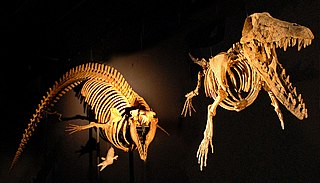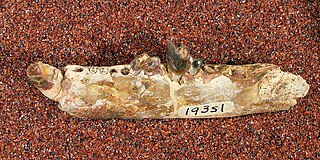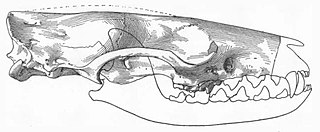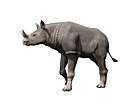
Miacis is an extinct genus of placental mammals from clade Carnivoraformes, that lived in North America from the early to middle Eocene.
Pakotitanops is a genus of poorly known brontothere represented only by a few tooth fragments. Its fossil dates from the middle Eocene Kuldana Formation, in the Ganda Kas area of Pakistan. Because this species is known only from a few tooth fragments it is difficult to compare it to other species to determine if it is indeed a distinct species and to what other species it is mostly closely related.

Archaeoceti, or Zeuglodontes in older literature, is a paraphyletic group of primitive cetaceans that lived from the Early Eocene to the late Oligocene. Representing the earliest cetacean radiation, they include the initial amphibious stages in cetacean evolution, thus are the ancestors of both modern cetacean suborders, Mysticeti and Odontoceti. This initial diversification occurred in the shallow waters that separated India and Asia 53 to 45 mya, resulting in some 30 species adapted to a fully oceanic life. Echolocation and filter-feeding evolved during a second radiation 36 to 35 mya.

Carnivoramorpha is a clade of placental mammals of clade Pan-Carnivora from mirorder Ferae, that includes the modern order Carnivora and its extinct stem-relatives.

Machaeroides ("dagger-like") is an extinct genus of sabre-toothed predatory placental mammals from extinct subfamily Machaeroidinae within extinct family Oxyaenidae, that lived in North America (Wyoming) from the early to middle Eocene.

Vulpavus is an extinct paraphyletic genus of placental mammals from clade Carnivoraformes, that lived in North America from the early to middle Eocene.

Miocyon is an extinct genus of placental mammals from clade Carnivoraformes, that lived in North America from the early to late Eocene.

Oodectes is an extinct paraphyletic genus of placental mammals from clade Carnivoraformes, that lived in North America from the early to middle Eocene.

Palaearctonyx is an extinct genus of omnivorous placental mammals from clade Carnivoraformes, that lived in North America from the early to middle Eocene.

Uintacyon is an extinct paraphyletic genus of placental mammals from clade Carnivoraformes, that lived in North America from the early to middle Eocene.

Quercygale is an extinct genus of placental mammals from the clade Carnivoraformes, that lived in Europe during the early to late Eocene.

Sinopa is an extinct genus of placental mammals from extinct family Sinopidae within extinct order Hyaenodonta, that lived in North America and Asia from the early to middle Eocene.

Lesmesodon is an extinct genus of placental mammals from extinct family Proviverridae within extinct superfamily Hyaenodontoidea, that lived during the Early to Middle Eocene. It was found in France and in the Messel Pit in Germany. Lesmesodon was a weasel-sized carnivorous mammal.

Apterodon is an extinct genus of hyaenodontid mammals that lived from the late Eocene through the middle Oligocene epoch in Africa and Europe. It is closely related to the African Quasiapterodon, and together it, they comprise the hyainailurids subfamily Apterodontinae.

Limnocyon is an extinct paraphyletic genus of limnocyonid hyaenodonts that lived in North America during the middle Eocene. Fossils of this animal have been found in California, Utah and Wyoming.

Viverravus is an extinct genus of placental mammals from extinct subfamily Viverravinae within extinct family Viverravidae, that lived in North America, Europe and Asia from the middle Paleocene to middle Eocene.
Ernestokokenia is an extinct genus of mammal, belonging to the Didolodontidae. It lived during the Early Eocene and the Middle Eocene, and its fossils were discovered in South America.

Isotemnus is an extinct genus of notoungulate belonging to the family Isotemnidae. It lived from the Late Paleocene to the Middle Eocene of what is now Argentina.
Colbertia is an extinct genus of oldfieldthomasiid notoungulate. It lived from the Early to the Middle Eocene, and its fossilized remains were discovered in Argentina and Brazil.

Limnocyoninae is a subfamily of extinct predatory mammals from extinct order Hyaenodonta. Fossil remains of these mammals are known from late Paleocene to late Eocene deposits in North America and Asia. Limnocyonines had only two molars in the upper and lower dentition.

























